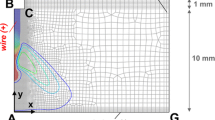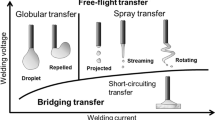Abstract
The gas metal arc welding (GMAW) process combines aspects of arc plasma, droplet transfer, and weld pool phenomena. In the GMAW process, an electrode wire is melted by heat from an arc plasma, and molten metal at the wire tip is deformed by various driving forces such as electromagnetic force, surface tension, and arc pressure. Subsequently, the molten droplet detaches from the tip of the wire and is transferred to the base metal. The arc plasma shape changes together with the metal transfer behavior, so the interaction between the arc plasma and the metal droplet changes from moment to moment. In this paper, we describe a unified arc model for GMAW, including metal transfer. In the model, we do not account for heat transfer in the metal, but the wire melting rate is determined by the arc current. The developed model can show transition from globular transfer at low currents to spray transfer at higher currents. It was found that electromagnetic force is the most important factor at high currents, but surface tension is more important than electromagnetic force at low currents in determining the transfer mode.














Similar content being viewed by others
References
Ruckdeschel WEW (1976) Classification of metal transfer. IIW Doc. XII-636-76
Ludwig HC (1957) Metal transfer characteristics in gas-shielded arc welding. Weld J 36:23s–26s
Needham JC, Cooksey CJ, Milner DR (1960) Metal transfer in inert-gas shielded-arc welding. Br Weld J 7:101–114
Liu S, Siewert TA (1989) Metal transfer in gas metal arc welding: droplet rate. Weld J 68:52s–58s
Lesnewich A (1958) Control of melting rate and metal transfer in gas-shielded metal-arc welding part II—control of metal transfer. Weld J 37:418s–425s
Rhee S, Kannatey-Asibu E Jr (1992) Observation of metal transfer during gas metal arc welding. Weld J 71:381s–386s
Kim Y-S, Eagar TW (1993) Analysis of metal transfer in gas metal arc welding. Weld J 72:269s–278s
Jones LA, Eagar TW, Lang JH (1998) Images of a steel electrode in Ar-2%O2 shielding during constant current gas metal arc welding. Weld J 77:135s–141s
Greene WJ (1960) An analysis of transfer in gas-shielded welding arc. Trans AIEE Part 2 7:194–203
Amson JC (1965) Lorentz force in the molten tip of an arc electrode. Br J Appl Phys 16:1169–1179
Waszink JH, Graat LHJ (1983) Experimental investigation of forces acting on a drop of weld metal. Weld J 62:108s–116s
Allum CJ (1985) Metal transfer in arc welding as a varicose instability: I. Varicose instabilities in a current-carrying liquid cylinder with surface tension. J Phys D Appl Phys 18:1431–1446
Allum CJ (1985) Metal transfer in arc welding as a varicose instability: I. Development of model for arc welding. J Phys D Appl Phys 18:1447–1468
Nemchinsky VA (1994) Size and shape of the liquid droplet at the molten tip of an arc electrode. J Phys D Appl Phys 27:1433–1442
Simpson SW, Zhu P (1995) Formation of molten droplet at a consumable anode in an electric welding arc. J Phys D Appl Phys 28:1594–1600
Choi SK, Yoo CD, Kim Y-S (1998) Dynamic simulation of metal transfer in GMAW, part 1: globular and spray transfer modes. Weld J 77:38s–44s
Choi SK, Yoo CD, Kim Y-S (1998) The dynamic analysis of metal transfer in pulsed current gas metal arc welding. J Phys D Appl Phys 31:207–215
Wang G, Huang PG, Zhang YM (2003) Numerical analysis of metal transfer in gas metal arc welding. Metall Mater Trans B 34B:345–353
Kadota K, Hirata Y (2011) Numerical model of metal transfer using an electrically conductive liquid. Weld World 55:50–55
Wang F, Hou WK, Hu SJ, Kannatey-Asibu E, Schultz WW, Wang PC (2003) Modelling and analysis of metal transfer in gas metal arc welding. J Phys D Appl Phys 36:1143–1152
Haidar J, Lowke JJ (1996) Predictions of metal droplet formation in arc welding. J Phys D Appl Phys 29:2951–2960
Hu J, Tsai HL (2007) Heat and mass transfer in gas metal arc welding. Part II: the metal. Int J Heat Mass Transf 50:808–820
Xu G, Hu J, Tsai HL (2009) Three-dimensional modeling of arc plasma and metal transfer in gas metal arc welding. Int J Heat Mass Transf 52:1709–1724
Hertel M, Spille-Kohoff A, Fuessel U, Schnick M (2013) Numerical simulation of droplet detachment in pulsed gas-metal arc welding including the influence of metal vapour. J Phys D Appl Phys 46:224003
Hirt CW, Nichols BD (1981) Volume of fluid (VOF) method for the dynamics of free boundaries. J Comput Phys 39:201–225
Wilke CR (1950) A viscosity equation for gas mixtures. J Chem Phys 18(4):517–519
Murphy AB (2010) The effect of metal vapour in arc welding. J Phys D Appl Phys 43:434001
Cram LE (1985) Statistical evaluation of radiative power losses from thermal plasmas due to spectral lines. J Phys D Appl Phys 18:401–411
Menart J, Malik S (2002) Net emission coefficients for argon-iron thermal plasmas. J Phys D Appl Phys 35:867–874
Brackbill JU, Kothe DB, Zamach C (1992) A continuum method for modeling surface tension. J Comput Phys 100:335–354
Rao ZH, Hu J, Liao SM, Tsai HL (2010) Modeling of the transport phenomena in GMAW using argon–helium mixtures. Part I—the arc. Int J Heat Mass Transf 53:5707–5721
Hirata Y (1994) Physics of welding—melting rate and temperature distribution of electrode wire. J Jpn Weld Soc 63(7):484–488 (in Japanese)
Lowke JJ (2009) Physical basis for the transition from globular to spray modes in gas metal arc welding. J Phys D Appl Phys 42:135204
Hirata Y (2003) Pulsed arc welding. Weld Int 17:98–115
Author information
Authors and Affiliations
Corresponding author
Additional information
Doc. IIW-2533, recommended for publication by Study Group SG-212 “The Physics of Welding”.
Rights and permissions
About this article
Cite this article
Ogino, Y., Hirata, Y. Numerical simulation of metal transfer in argon gas-shielded GMAW. Weld World 59, 465–473 (2015). https://doi.org/10.1007/s40194-015-0221-8
Received:
Accepted:
Published:
Issue Date:
DOI: https://doi.org/10.1007/s40194-015-0221-8




